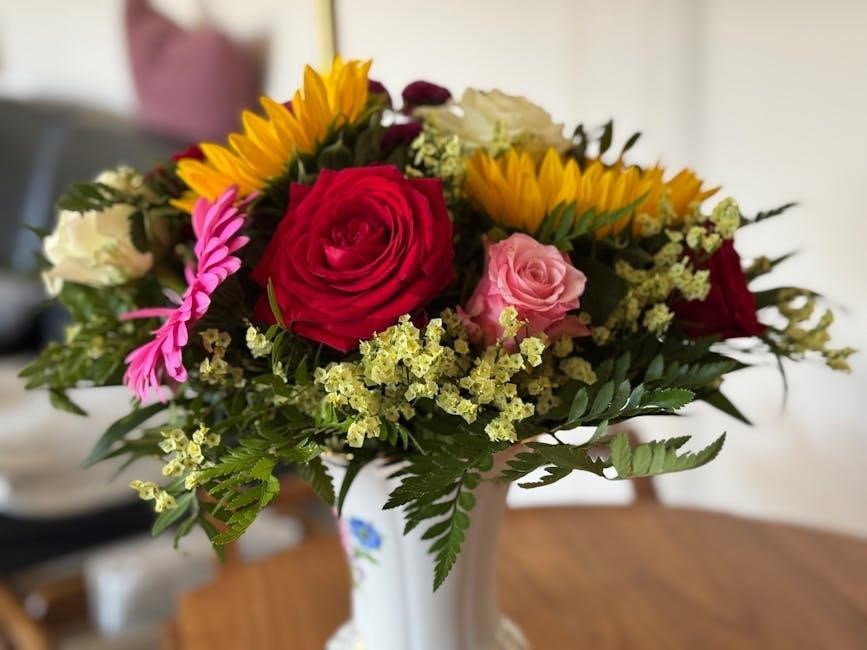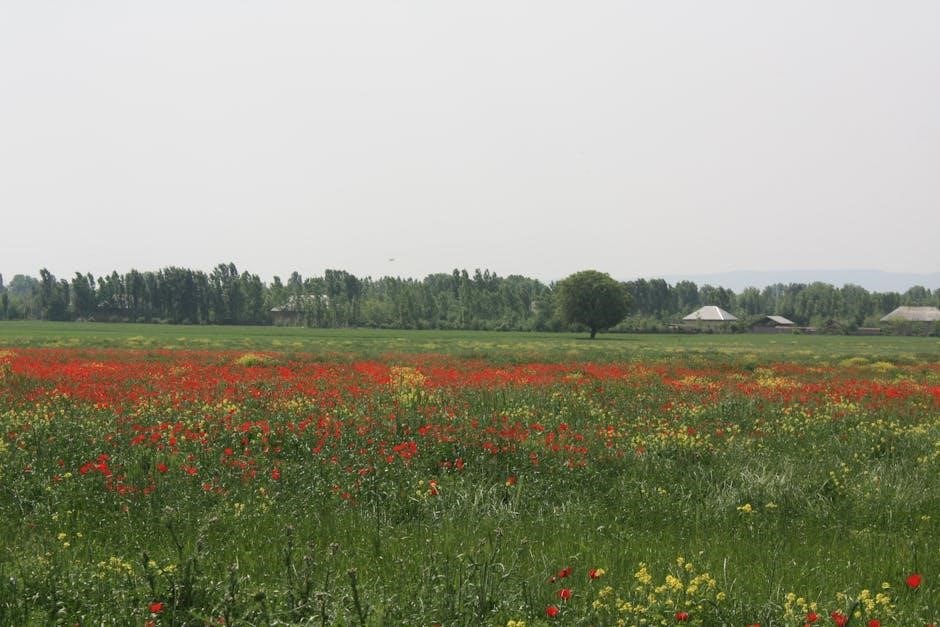Cultural Relevance
Alice Walker’s “The Flowers” reflects the 1970s cultural context by addressing racial violence and innocence lost, resonating with ongoing discussions of systemic racism and social injustice today.
1.1 Reflection of the 1970s Cultural Context
Alice Walker’s “The Flowers” is deeply rooted in the cultural and racial tensions of the 1970s, reflecting the harsh realities of the Deep South during this period. The story captures the innocence of childhood juxtaposed with the brutality of racial violence, a theme that resonated strongly during the Civil Rights era. Myop’s journey through the woods symbolizes the loss of innocence as she encounters the remnants of a lynched man, a direct reference to the racial atrocities that plagued American history. The narrative subtly critiques the systemic racism embedded in Southern society, echoing the broader cultural conversations of the 1970s about identity, justice, and equality. Walker’s concise yet powerful storytelling highlights the enduring impact of historical violence on individual and collective consciousness, making the story a poignant reflection of its time.
1.2 Ongoing Relevance in Modern Society
Alice Walker’s “The Flowers” maintains its relevance in modern society by addressing themes that remain poignant today, such as racial injustice, the loss of innocence, and the harsh realities of systemic oppression. Myop’s experience mirrors the contemporary struggles of marginalized communities, where violence and discrimination continue to disrupt lives. The story’s exploration of innocence shattered by racial violence resonates with current discussions on police brutality, racial profiling, and the Black Lives Matter movement. Walker’s use of symbolism, particularly the flowers, serves as a powerful metaphor for the fragility of life and the enduring impact of historical trauma. The narrative’s concise yet impactful style allows it to transcend time, making it a critical tool for teaching about social justice and human rights in modern educational settings. Its themes continue to provoke reflection and dialogue, ensuring its relevance in today’s socio-political landscape.

Psychological Impact on Myop
The discovery of the lynched man in the woods leaves Myop emotionally shattered, eroding her childhood innocence and replacing it with a haunting awareness of racial violence and mortality.
2.1 Immediate Emotional Response
Myop’s discovery of the lynched man triggers a profound and immediate emotional shift. Her carefree demeanor dissolves into shock, fear, and confusion. The vibrant, joyful world she once perceived is abruptly replaced with the harsh reality of racial violence. The flowers, once symbols of innocence and beauty, now contrast starkly with the grimness of death. Myop’s heart races as she processes the horror, her mind grappling with the brutality of the act. This moment marks a sudden loss of innocence, leaving her with a haunting sense of vulnerability. The emotional impact is visceral, reshaping her understanding of the world and its dangers, forever altering her perspective on life and humanity.

2.2 Long-Term Mental and Emotional Effects
The traumatic discovery of the lynched man leaves Myop with lasting mental and emotional scars. Her innocence is irreparably lost, replaced by a deep-seated awareness of racial violence and injustice. The incident instills a lingering fear and mistrust, altering her perception of the world as a safe and loving place. Myop’s once vibrant and carefree spirit is dampened, as she grapples with the harsh realities of her environment. The memory of the flowers, now tainted by the brutality she witnessed, serves as a constant reminder of her loss of naivety. Over time, this experience shapes her identity, fostering a heightened sensitivity to the injustices faced by her community. The emotional toll of this event resonates throughout her life, influencing her worldview and understanding of societal inequities.
Comparative Analysis with Other Works
Alice Walker’s “The Flowers” shares themes of racial injustice and lost innocence with works like “To Kill a Mockingbird,” both exploring societal impacts through a child’s perspective.
3.1 Similar Themes in Walker’s Other Stories
Alice Walker’s “The Flowers” mirrors themes found in her other works, such as “Everyday Use” and “The Color Purple,” which emphasize racial identity, injustice, and the loss of innocence. These stories often depict young protagonists grappling with harsh realities, reflecting Walker’s focus on the African-American experience. The use of symbolism, particularly flowers, is recurrent, representing purity and its destruction. Walker’s concise yet powerful narrative style, as seen in her flash fiction, underscores the emotional weight of her characters’ journeys. This consistency in exploring societal oppression and personal growth solidifies her unique voice in literature, making her works timeless and universally relatable.

3.2 Contrast with Contemporary Literature
“The Flowers” stands out against contemporary literature by its concise, impactful storytelling, which contrasts with modern tendencies toward lengthy, detailed narratives. Walker’s direct approach, typical of flash fiction, delivers a poignant message without elaboration, a departure from today’s often complex plots. The story’s focus on racial violence and innocence loss resonates deeply, differing from many current works that explore diverse themes. Its historical context provides a unique lens, distinguishing it from modern fiction’s often global perspectives. The minimalistic style and heavy symbolism in “The Flowers” highlight its timeless relevance, offering a stark yet powerful commentary on social issues that remains unparalleled in much of today’s literature. This brevity and depth ensure its continued study and appreciation in educational settings, making it a significant work in both past and present literary landscapes.

Narrative Style and Technique
Alice Walker employs a third-person perspective, creating a detached tone that heightens the emotional impact of Myop’s discovery. The story’s brevity and symbolism exemplify flash fiction mastery, emphasizing themes succinctly. Walker’s concise language and vivid imagery underscore the narrative’s power, making it a prime example of effective micro-fiction technique. The structured, chronological progression adds to the story’s intensity, ensuring a lasting impression on readers. The minimalist approach allows deeper thematic exploration, showcasing Walker’s storytelling prowess. The narrative’s clarity and focus maintain engagement, while the symbolic elements enhance its depth and resonance. This style ensures the story’s universal appeal and educational value, making it a cornerstone of literary study. The techniques used demonstrate Walker’s ability to convey profound messages through simplicity, a hallmark of her writing. The narrative’s precision and impact highlight its relevance in contemporary literature, solidifying its place as a seminal work. The story’s condensed format and symbolic richness provide a compelling case for its inclusion in academic curricula, ensuring its continued analysis and appreciation.
4.1 Use of Third-Person Perspective
Alice Walker’s use of the third-person perspective in “The Flowers” creates a detached yet intimate narrative voice, allowing readers to observe Myop’s journey objectively. This perspective emphasizes the universality of the story, making Myop’s experience relatable beyond her individual circumstances. The third-person narration also heightens the emotional impact by maintaining a balance between observation and empathy. Walker’s choice of perspective enables the reader to witness Myop’s innocence and its subsequent shattering without being overly intrusive, which underscores the story’s tragic inevitability. The narrative’s objectivity further highlights the broader societal issues, such as racial violence, by presenting them as observed realities rather than personal biases. This technique ensures that the story’s themes resonate on both a personal and cultural level, enhancing its cultural relevance and emotional depth. The perspective effectively bridges the gap between the individual and the collective experience, making the narrative both powerful and poignant.
4.2 Flash Fiction and Micro-Fiction Techniques
Alice Walker’s “The Flowers” exemplifies flash fiction through its concise yet impactful structure, delivering a profound narrative within a brief format. The story’s brevity forces every element—character, setting, and symbol—to carry significant weight, contributing to its emotional intensity. Walker employs vivid imagery and subtle symbolism, such as the flowers and the woods, to convey themes of innocence and violence without explicit elaboration. The story’s tight focus on a single, transformative event allows for a concentrated exploration of Myop’s experience, making the narrative both intimate and universal; This technique ensures that the story’s themes linger with the reader long after the conclusion, underscoring the power of flash fiction to evoke deep reflection through minimal words. Walker’s mastery of micro-fiction techniques in “The Flowers” highlights her ability to distill complex emotions and societal issues into a spare, yet potent, narrative form. The story’s concise nature enhances its accessibility and impact, making it a significant work in the flash fiction genre.

The Role of Nature
Nature in “The Flowers” serves as a dual symbol, with flowers representing innocence and the woods embodying danger, reflecting Myop’s tragic confrontation with racial violence.
5.1 Symbolism Beyond Flowers
Beyond the flowers, nature in “The Flowers” holds profound symbolism. The woods, often a place of mystery and danger, contrast sharply with the vibrant, innocent flowers Myop collects. The discovery of the lynched man’s remains transforms the natural setting into a grim reminder of racial violence. The rope and skeleton serve as stark symbols of brutality, while the flowers Myop gathers symbolize her lost innocence. The natural world, once full of beauty and wonder, becomes a backdrop for harsh reality. This juxtaposition underscores the destruction of childhood innocence and the pervasive impact of racism. The woods, typically a place of exploration and curiosity, instead reveal the darker truths of society. Through this, Walker uses nature to convey both the beauty of innocence and the ugliness of racial hatred, creating a powerful and haunting narrative.
5.2 The Woods as a Symbol of Mystery and Danger
The woods in “The Flowers” symbolize mystery and danger, serving as a transformative setting for Myop’s journey. Initially, they appear idyllic, filled with vibrant flowers and life. However, as Myop ventures deeper, the woods reveal their darker side. The discovery of the lynched man’s remains shifts the woods from a place of childhood wonder to one of horror. This transformation underscores the duality of nature—beauty and brutality coexisting. The woods, often associated with exploration and innocence, here become a space of violent revelation. Walker uses the woods to highlight the harsh realities of racial violence, contrasting the innocence of Myop’s world with the brutal truths of society. The woods, thus, serve as both a literal and metaphorical threshold, marking Myop’s transition from innocence to awareness. This symbolism enriches the narrative, making the woods a poignant backdrop for the story’s tragic unfolding.
Reception and Reviews
“The Flowers” was praised for its emotional depth and concise storytelling. Initially controversial, it has become a widely studied piece, reflecting its enduring impact and relevance in literature.

6.1 Initial Reception in 1973
When “The Flowers” was first published in 1973, it sparked mixed reactions due to its graphic portrayal of racial violence. Critics praised its concise storytelling and emotional depth, while some found the subject matter unsettling. The story’s inclusion in Walker’s short-story collection helped it gain attention, though its controversial themes initially limited its acceptance. Despite this, educators began incorporating it into curricula for its ability to provoke meaningful discussions about race and innocence. Over time, the story’s cultural significance grew, solidifying its place in American literature as a powerful exploration of racial violence and its impact on young lives. Its initial reception laid the groundwork for its enduring relevance in addressing systemic racism and the loss of innocence.
6.2 Evolution of Critical Perception
Over the years, critical perception of “The Flowers” has evolved, with scholars increasingly recognizing its nuanced exploration of race, innocence, and societal brutality. Initially praised for its storytelling, the story’s deeper themes, such as the symbolism of flowers and the woods, gained more attention in later analyses. Critics began to appreciate how Walker’s use of a child’s perspective heightened the emotional impact of the narrative. The story’s brevity, once seen as a limitation, is now celebrated as a masterful example of flash fiction. Modern critics also highlight its relevance to ongoing conversations about racial justice and the loss of innocence, cementing its status as a seminal work in American literature. This shift in critical perception underscores the story’s timeless ability to provoke reflection and dialogue.
Educational Use
Teachers often incorporate “The Flowers” into high school curriculum due to its concise yet powerful exploration of racial injustice and innocence. Its brevity makes it an ideal text for analyzing literary devices, fostering discussions on race, and understanding historical contexts, enhancing students’ critical thinking skills.
7.1 Integration into High School Curriculum
Alice Walker’s “The Flowers” is frequently included in high school English curricula due to its concise yet impactful exploration of themes such as racial injustice, innocence, and coming of age. The story’s brevity and vivid imagery make it an ideal text for teaching literary analysis, symbolism, and historical context. Educators often use the narrative to introduce students to the realities of the Jim Crow era and to spark discussions about systemic racism. The story’s focus on a young protagonist, Myop, allows students to connect with her emotional journey, fostering empathy and critical thinking. Additionally, the text’s accessibility enables teachers to guide students through close readings, thematic discussions, and reflective writing exercises, making it a valuable tool for developing analytical and interpersonal skills.
7.2 Teaching Approaches and Discussions
Teaching “The Flowers” often involves fostering a reflective and analytical classroom environment. Educators employ Socratic seminars and group discussions to explore themes of racial violence, innocence, and societal injustice. Students are encouraged to analyze Myop’s emotional transformation and the symbolic use of flowers. Discussions frequently focus on the historical context of lynching and its impact on African American communities. Teachers also guide students in interpreting the woods as a symbol of danger and mystery, contrasting with Myop’s initial innocence. Writing exercises, such as reflective essays, help students process the story’s emotional weight. Additionally, educators often connect the narrative to broader discussions on social justice, prompting students to consider the ongoing relevance of the story’s themes in modern society. This approach not only enhances literary understanding but also promotes empathy and critical thinking among students.
Adaptations and Interpretations
The story has inspired scholarly interpretations and educational adaptations, often used in literature courses to explore themes of racial injustice and loss of innocence through symbolic analysis and reflection.
8.1 Adaptations into Other Media
Alice Walker’s “The Flowers” has been adapted into various media forms, enhancing its accessibility and impact. A notable film adaptation brings the story to life, visually capturing Myop’s journey and emotional transformation. Additionally, stage productions have dramatized the narrative, emphasizing the cultural and historical context. Audio versions, including podcasts and readings, offer an auditory experience, making the story accessible to a broader audience. Educational materials, such as study guides and interactive media, facilitate deeper analysis of the themes and symbols, aiding students in understanding the story’s significance. These adaptations not only preserve the story’s essence but also extend its reach, ensuring its relevance across different platforms and learning styles. Through these diverse formats, “The Flowers” continues to resonate, providing a multi-dimensional exploration of its poignant message. This versatility underscores the story’s enduring importance in literature and education.
8.2 Significant Scholarly Interpretations
Scholars have extensively analyzed “The Flowers” for its profound exploration of racial violence, innocence, and societal oppression. Many interpret the story as a powerful critique of the Jim Crow era, highlighting how Myop’s discovery symbolizes the brutal realities of racism. Houston Baker, a prominent literary critic, notes the story’s use of symbolic flowers to represent both innocence and its violent destruction. Others, like scholar Barbara Christian, emphasize the narrative’s silence on overt violence, arguing it underscores the normalized brutality of lynching in American history. The story is also seen as a microcosm of Walker’s broader themes of identity, trauma, and resilience. Its brevity and symbolism make it a focal point in discussions about flash fiction’s ability to convey complex social commentary. These interpretations underscore the story’s enduring relevance in academic and cultural discourse.

The Title’s Significance
The title “The Flowers” symbolizes Myop’s innocence and its tragic loss, contrasting the beauty of nature with the ugliness of racial violence, creating a haunting paradox.
9.1 Why “The Flowers” was Chosen
“The Flowers” is a title that juxtaposes the innocence and beauty of childhood with the harsh reality of racial violence. Alice Walker chose this title to symbolize Myop’s journey from innocence to awareness, using flowers to represent her youthful joy and curiosity. The title’s simplicity contrasts with the profound tragedy of the story, where the discovery of a lynched man shatters Myop’s naivety. By naming the story after the flowers, Walker emphasizes the loss of innocence and the brutal awakening to the realities of racism and violence. The title also serves as a metaphor for the fragility of life and the destruction of purity, highlighting the themes of racial injustice and the abrupt end to childhood innocence.
9.2 Multifaceted Meanings of the Title
The title “The Flowers” holds multiple layers of meaning, extending beyond its literal interpretation. Symbolically, flowers represent innocence, purity, and beauty, attributes embodied by the protagonist, Myop. However, the discovery of the lynched man transforms these symbols into emblems of loss and tragedy. The title also subtly alludes to the fleeting nature of childhood and the harsh realities of racial violence in the Jim Crow South. Furthermore, the flowers Myop collects can be seen as a metaphor for the fragments of her shattered innocence, each bloom representing a piece of her lost youth. The title’s simplicity belies its profound implications, making it a powerful and enduring element of the story’s themes and impact.
Historical Accuracy
Alice Walker’s “The Flowers” accurately portrays the racial violence and lynching practices prevalent in the Deep South during the Jim Crow era, reflecting historical truths.
10.1 Alignment with Historical Events
Alice Walker’s “The Flowers” aligns with the historical realities of racial violence in the Deep South during the Jim Crow era. The story reflects the atrocities of lynching, a practice systematically used to terrorize African Americans. Myop’s discovery of the decomposed body of a lynched man mirrors the countless unreported racial murders of the time. The isolated woods serve as a haunting backdrop, symbolizing the secrecy and impunity with which such crimes were committed. Walker’s portrayal of the Deep South’s racial tensions and the brutal consequences for African Americans is historically accurate, drawing from the era’s pervasive injustice. The narrative underscores the failure of Reconstruction and the rise of white supremacist groups, which perpetuated violence against Black communities. By depicting these events, Walker highlights the enduring impact of racial violence on individuals and society, making the story a poignant reflection of America’s troubled past.
10.2 Portrayal of Lynching Practices
Alice Walker’s “The Flowers” vividly portrays the brutal reality of lynching practices in the Deep South during the Jim Crow era. The story subtly yet powerfully depicts the aftermath of such violence through Myop’s discovery of a lynched man’s remains. Walker’s narrative aligns with historical records, as lynching was a tool of racial terror used to intimidate African Americans. The story’s emphasis on the unmarked, decomposing body reflects the dehumanizing nature of these crimes, often committed with impunity; By placing the body in the woods, Walker underscores the secrecy and fear surrounding lynching, which was frequently hidden from public view. The portrayal serves as a haunting reminder of the era’s racial violence, highlighting its psychological and emotional toll on individuals and communities. Walker’s depiction educates readers about this dark historical practice and its enduring impact.